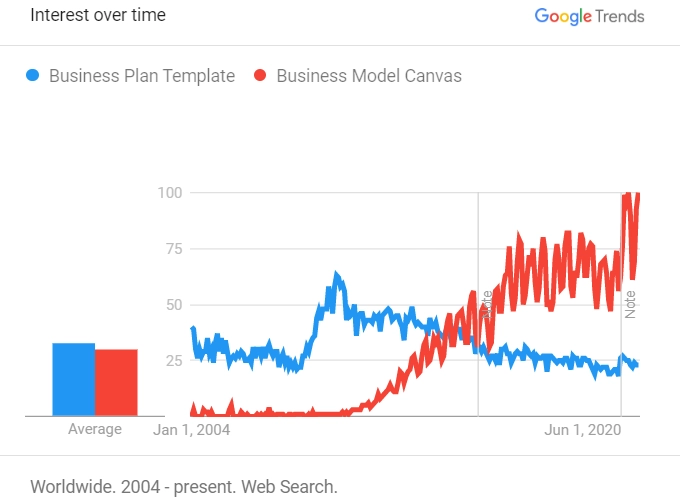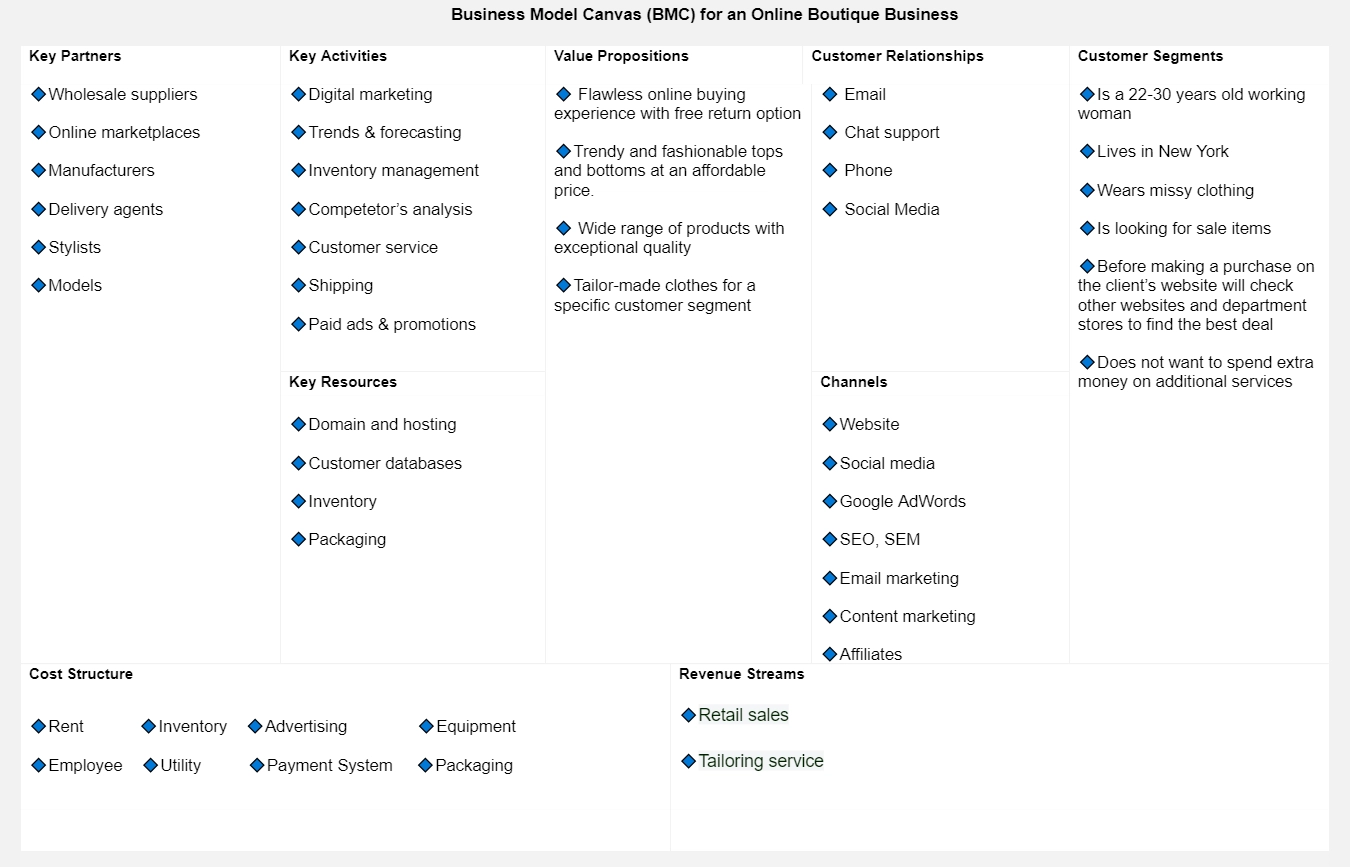Online Boutique Business Plan/Canvas Template [2024]
Are you looking for a business plan to kick off your online boutique business? Wait. We have something better for you — A Business Model Canvas (BMC)!
A simple Google Trends analysis reveals how organizations and entrepreneurs have shifted from the traditional business plan to a more concise, visual, and strategic alternative — the Business Model Canvas.
Why is it better?
“Business Model Canvas has revolutionized how to think about new ventures.” Steve Blank, Stanford
Traditional business plans are lengthy, time-consuming, and really bad for brainstorming. It becomes really hard to organize and consolidate ideas without summarizing the key aspects of your boutique business.
Whereas a Business Model Canvas helps you visualize the most important elements to launch your online boutique. It is a one-page document that helps you structure your business model visually. It saves tons of your time and helps you close the planning gaps between different business segments. You can easily update the BMC to your liking.
Business Plan Vs. Business Canvas
Here’s a table depicting the main differences between a Business Plan and a Business Model Canvas:
Business Model Canvas
Business Plan:
A concise one-page document with nine sections
A lengthy document comprising multiple pages and sections
Provides a quick overview of the key elements of a business — key partners, key activities, value proposition, etc.
Contains too many details about the business, its products & services, competitors & customers, financial goals, SWOT analysis, etc.
More visual
Lots of text
Great for brainstorming
Not suitable for brainstorming
Business canvas is made to be tested
A business plan explains how a business might become viable
Easily readable and customizable
Takes a lot of time to update it
Helps you close the planning gaps and chase customers — usually used when you are still testing ways to launch your business
A lot of time is wasted analyzing performance and sticking to the initial business plan
Helps you launch your business by applying a customer-proven process
Talks about future plans and strategies
Focuses on how a business might create value
More focused on how a business might become profitable
Easily adapts to market changes
Becomes out of date as soon as it’s written
Online Boutique Business Canvas [Free Template]
You can find the online boutique business canvas here. You can copy the document and use it for your own venture.
How To Use/Apply the Business Model Canvas?
Now we know what a Business Model Canvas is and how it is different from a Business plan, it's time to see how to use the BMC to focus on your business's key drivers:
There are 9 sections in a business model canvas:
- Customer Segments
- Value Proposition
- Channel
- Customer Relationships
- Revenue Streams
- Key Activities
- Key Resources
- Key Partners
- Cost Structure
Customer Segments:
This is the process of categorizing your customers based on age, gender, interests, and other demographics & psychographics. This will help identify each segment's buyer persona to understand their needs better and decide on which channel you will sell your items.
Moreover, you can classify which communication channel is better suited to a specific customer segment. For example, if you are targeting teens, social media will be the best channel out there, but for the elderly, it might be television or print media. Furthermore, you can decide which customer segment you should invest more on, what type of people are interested in your product, why they are interested, and how you can bring more sales.
- Who is going to benefit from your value proposition?
- Which demographics need your product?
- What are the characteristics of the people interested in your product?
Customer segments for an online boutique business entirely depend on what type of clothing you are going for. If it is sportswear, young adults aged 20 to 30 or teenagers will be buying from you.
Value Proposition
Value proposition is the centerpiece of your business. This defines what problem your business is trying to solve and what sets it apart from the rest of the competition.
When you are just starting out, just list down every value proposition that comes into your mind. It might be about the quality of the product, the way you deliver it, or the after-sale services. Identifying why customers prefer you over the current alternatives takes a bit of time.
Defining a value proposition helps you identify your business's key resources, activities, and partners. In short, value proposition drives everything in your business — how you reach out to your prospective buyers, demonstrate your product, sell it, what channels you’ll be using, etc.
“We sell tops.” Does this seem like a proper value proposition to you? Not really.
Your value proposition helps you figure out what problem your customers are facing and how you are going to give them a unique solution — something better than current alternatives.
- What does your ideal customer segment need from you? Unique brands, lower prices, sustainable products or else?
- Why would someone need your product/services? No other option near the town, better customer service?
For an online boutique business, the value proposition can be about the variety of items, their quality, affordability, comfort/utility, or design.
Channels:
Channels are simply the mediums through which you can reach out to your customers, communicate your value proposition, and later provide customer services. This includes identifying the possible channels and separating the most effective ones.
For example, traditional television might not be a good channel to target teens, but Facebook and Google Ads have proven to be very effective in this case. Identifying channels will also help you decide where to sell your product. Each customer segment might need a separate channel.
- Which channel is the most effective one?
- Is there a particular customer segment that prefers one channel over the other?
- Where are your ideal customers?
A business website, social media, paid ads, email and content marketing, and affiliates are the best channels for an online boutique business.
Customer Relationship:
As obvious from the name, this section talks about how a customer interacts with your business all the way from making the purchase to the end of the product cycle. Customer relationship also includes social media and digital marketing channels, as these are also a way to interact with customers.
Can the customers interact with you face-to-face? Or is it just online? Brick-and-mortar stores and exclusive online stores interact differently with the customers. Some businesses also use third-party contractors to automate this process. Filling out the customer relationship section will help you identify all these channels.
- How will you interact with your customers?
- Will there be a different mode of communication for each customer segment?
- Is your business offering personal or exclusive support?
For an online boutique business, a business website, social media, live chat, and phone are the obvious modes of communication.
Revenue Streams:
This section is pretty straightforward. Revenue streams are the ways your business makes money. For an online boutique business, your main revenue stream will be selling your inventory with a margin.
- Did you decide how much margin you will add on items?
- Will all have the same margin or will you differentiate them?
Key Activities:
This section includes the list of all day-to-day activities that need to be done to deliver your value proposition.
Key activities explain the tasks required to support and sustain your business model. This contains everything from your value proposition and advertising model to customer relationships and revenue sources.
Putting down your key activities will help you filter the tasks that you must perform to keep your business running and the key resources needed to perform these key tasks.
- Which key activities allow your business to provide services?
- Which key activities contribute to your marketing, sales, and advertising efforts?
- Which key activities support technical development?
For an online boutique business, your key activities will be digital marketing (to drive sales), trends & forecasting (supply and demand), inventory management, customer service, etc.
Key Resources:
You need some resources to run your business. This may include physical ones like office space, material, etc., human resources, intellectual property, software products, and more. You can figure out the key resources by looking at your key activities, value proposition, and customer segments.
Why is this so important? People tend to go overboard with a new business. For example, an online boutique does not require office space, lots of employees, PCs, etc., to deliver value to the customer. Identifying your key resources will also help you bring down costs by investing in only the necessary stuff.
- Which key resources do you need to perform your key activities?
- What type of key resources do you need depending on the type of business — product-driven, Scope-driven, and Infrastructure-driven?
- Should you focus more on the physical resources or virtual/software resources?
Your key resources for an online boutique business include a website, customer databases, inventory, etc.
Key Partners:
You need to acquire resources from partners to help perform certain key activities. This section contains all the external parties who you will collaborate with to deliver value to your customers.
Identifying your key partners will help streamline your key activities. You’ll know exactly what type of help you need to deliver your value proposition.
- Who are the key partners?
- Where are you going to buy wholesale clothing?
- Which key resources will you acquire from partners?
- How do the key partners contribute towards delivering your value proposition?
For an online boutique business, wholesale suppliers, online marketplace, delivery agents, etc., will be your key partners.
Cost Structure:
Cost structure illustrates where you spend the money to get key resources and perform key activities. Moreover, you also need to identify the fixed and variable costs. This also helps you decide how much profit margin you must set to keep the ball rolling. Without a clear cost structure, it will be difficult to track the expenses and leakages.
- How much money does it take to deliver the value proposition to your customers?
- Are there any additional costs? Employee salaries, taxes, ad costs, etc.
- How much revenue do you need to keep doing business?
- How much salary as a boutique owner will you get?
For an online boutique business, this entirely depends on your budget and value proposition.
Conclusion
A business model canvas helps you assess your business strategy, address specific risks, and identify the planning gaps between the nine sections of the BMC.
Do you want to create a strategy for your online boutique without taking too much time? Create a BMC today using our free Online Boutique Business Canvas Template!




